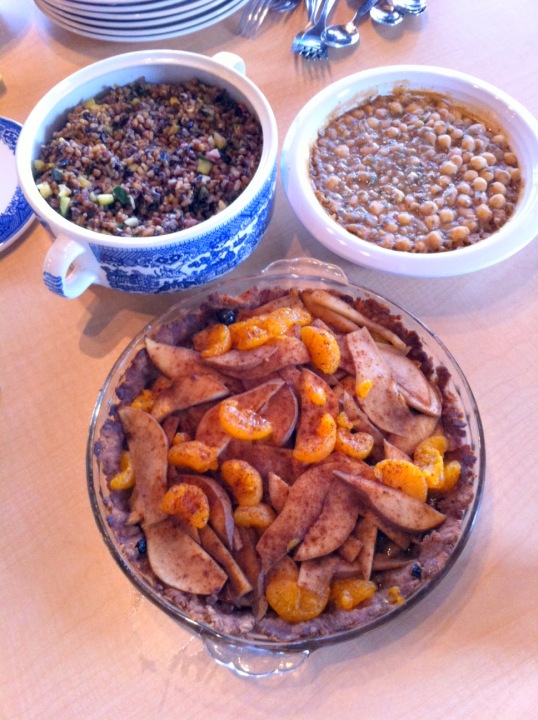Foods to Treat Phlegm
M.E. had the very special & daunting task of making delicious food that not only didn’t contribute to damp or phlegm in the boy, but actually combatted it! This was a particularly timely meal, too, as most of our heartier winter and holiday dishes lend themselves to damp formation. We were all especially pleased to indulge in a dessert which “sopped up” the dampness that the natural sugars could potentially create!
TCM pattern: Phlegm
Phlegm can be defined as yin fluids other than blood*, thickened and eventually hardened by heat or dryness (internal or external, full or empty), usually causing obstruction and stagnation of qi and blood in the channels and collaterals, vessels, tissues, and functional structures within the zangfu. It often combines with other pathogenic factors, especially heat and dampness, because the two will form phlegm if allowed to persist together; but it can also combine with wind, which can induce a wide variety of conditions from wandering bi to stroke. Dryness is a factor that may congeal yin fluid into phlegm in the absence of heat, but is a less common pairing.
* Blood stagnation is a separate pathology treated by moving qi and blood to break the stagnation, whereas phlegm is transformed or expectorated.
Signs and symptoms of phlegm pathologies include coughing, shortness of breath, asthma, bronchitis, pneumonia, chest oppression, lumps or nodules in the chest, abdomen, or extremities, but particularly along the channels, shen disturbance, high LDL, cancers, lethargy, depression, difficult to eliminate stool, tophi, sleep dysfunctions, certain discharges, and many more.
Foods to avoid are ones that typically increase dampness or heat which will exacerbate a phlegm condition. These include dairy, rich meat, roasted peanuts, concentrated juices such as orange or tomato, wheat, bread, yeast, beer, sugar, and fats. Some of these were difficult to eliminate as traditional dishes tend to be fairly balanced and include some of everything, or small amounts of items contraindicated to phlegm necessary for taste or construction.
For my menu I primarily chose foods that transform phlegm and drain dampness, as well as some moderate spiciness (warm and acrid) balanced with enough cooling action to neutralize the heat yet not increase dampness. Dishes and their ingredients are as follows:
Spicy Beans
Almond Oil, Garbanzo Beans, Great Northern Beans, Garlic, Sweet Onion, Thyme, Orange/Lemon Peel, Jalapeño, Mustard Seed.
Beans were soaked and simmered for long durations, then combined with the other ingredients until flavors cooperated.
Rice
Mixed Whole Grain Rice, Cucumber, Celery, Garlic, Thyme, Coconut Oil.
Rice by rice cooker (steam) for 2hrs, then combined with other ingredients.
Pie
Pear, Mandarin Orange, Banana, Walnut, 5 Spice.
Crust constructed first, then filled and baked for 1-2hrs. The fresh fruit made for a very moist filling such that it could have gone longer. Foil was used to cover the edges and top to prevent burning during the second half while liquid reduced.
Pie Crust
Walnut, Whole Wheat Flour, Mandarin Orange, Cinnamon, Nutmeg, Allspice.
Each of these dishes were prepared with proper amounts of the main ingredients and seasoned to taste, including small amounts of spices which are not listed. Unfortunately, exact recipes were not compiled during preparation due to seat-of-pants flying. Apologies to those wishing to recreate their favorites!
The three dishes were chosen to illustrate the variety of possibilities of phlegm resolving foods, that not only potent ethnic foods have this ability, and that one mustn’t cause their nose to run in order to eliminate this pathogenic factor.




